Huitong.com December 13th - Tuesday (December 13th) spot gold fluctuated within a narrow range. At present, the action of trading at the price of 1162.69 US dollars can be weakened. The physical gold premium of China and India is obvious, which provides support for gold prices. However, the market is worried about whether the Fed will continue to release the hawkish signal in the market's interest rate decision this week. The short-term upside of the gold price is limited. In the crude oil market, the IEA monthly report said that the reduction in production is expected to make the oil market supply shortage of 600,000 barrels per day in the first half of next year, helping the oil price to rise moderately, but the selling pressure of profit-taking is still heavier. 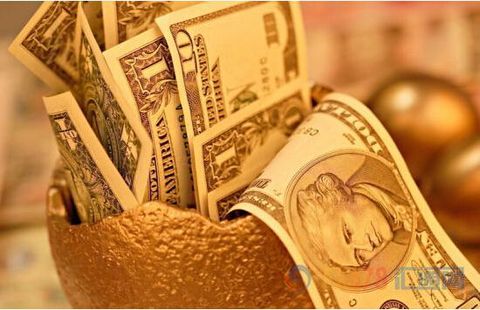
[China and India gold premium, the bulls still care about the Federal Reserve "spear eagle"]
The price of gold was still difficult on Tuesday. Although it was far from the overnight low of more than 10 months, the gold price premium between China and India and the two gold-consuming countries was obvious, but it was close to the Fed’s interest rate decision. The market generally expected the Fed to release the hawks while raising interest rates. The signal still limits the rebound of the gold price. 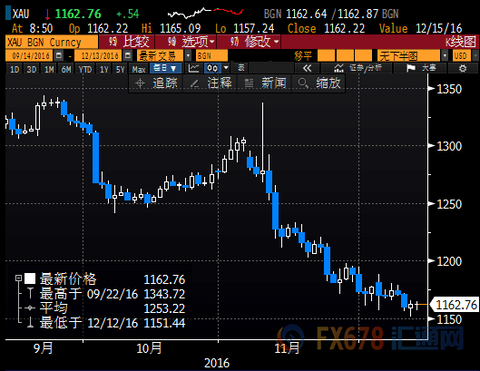
(Spot gold daily chart)
According to Reuters news, India's largest gold import bank (Axis Bank) suspended the use of bank accounts of some gold jewellery traders, as two managers of the bank were arrested for alleged money laundering. The move has caused Indian consumers to flock to buy gold and even be willing to buy gold at a 50% premium. In November, India’s gold imports surged to around 100 tons, a 11-month high.
In addition, last week China’s news of restricting gold imports pushed the Chinese gold premium to a three-year high. Currently only 15 banks are allowed to import gold, including 3 foreign banks. According to a Hong Kong bank, each bank has a funding quota. At present, the renminbi is weaker against the US dollar, and the festivals with strong traditional gold consumption demand such as the Spring Festival are also the driving force for the domestic gold premium.
Analysts believe that India is in the peak season of gold demand, China is also close to the Spring Festival, as the two countries with the world's largest physical demand for gold, the gold premium of these two countries still provide some support for spot gold in the fundamentals. But on Thursday (December 15th) Beijing time, the Fed is expected to raise interest rates for the first time in a year, and will even continue to release the hawkish signal, which is expected to limit the upside of the short-term gold price.
INTLFCStone analyst Edward Meir said in a report that GDP growth rate of 3%, accelerated inflation and the impending new government's dissatisfaction with the Fed's work may prompt the Fed to issue a more hawkish signal in the future.
The report said that if we are right, we should see an increase in interest rates and a stronger US dollar. These two factors may cause gold to encounter new selling. The price of gold may hit $1,140 at some point in December.
ANZ said in a report that as the Fed raises interest rates later this week, investors continue to sell gold.
According to Huitong.com, the data shows that since November 9th, the gold ETF holdings have been out of the state, the world's largest gold exchange-traded fund (ETF) - SPDR Gold Trust Monday (December 12) gold holdings compared to the previous one The trading day decreased by 0.14% to 856.26 tons, hitting a new seven-month low.
[IEA monthly report re-transmitted good news, oil prices rose moderately]
International oil prices rose slightly on Tuesday. US crude oil futures rose more than 1% to US$53.42/barrel in January, and Brent crude oil futures hit US$56.08/barrel in February. IEA released monthly report that oil supply in the first half of 2017 There may be a gap of 600,000 barrels, and the increase in demand in Asia also provides support for oil prices. However, the oil market still needs to pay attention to the selling pressure of profit-taking. On the technical side, the K-line left last long and the bulls have Be careful. 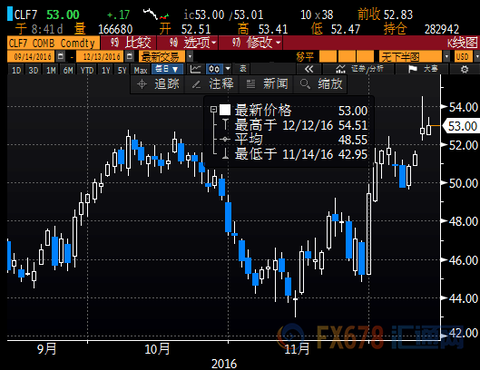
(US crude oil January futures daily chart) 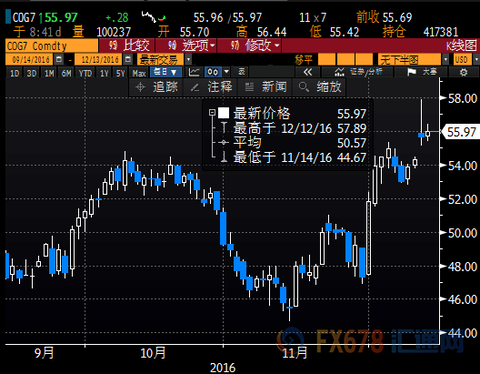
(Brent crude oil February futures daily chart)
The IEA announced a monthly report on Tuesday that the OPEC agreement will cause a shortage of oil supply in the first half of the year. If OPEC and non-OPEC countries comply with the production reduction agreement, the oil market will have a shortage of 600,000 barrels per day in the first half of the year, but this is based on the agreement. Estimated, not "IEA estimate" .
The IEA raised its forecast for global crude oil demand growth this year and next. The IEA said in its monthly report that it raised its forecast for 2016 crude oil demand growth by 120,000 barrels per day to 1.4 million barrels per day. Increased by 110,000 barrels per day to 1.3 million barrels per day. The global crude oil demand in 2017 will be raised to 97.6 million barrels per day due to the increase in demand from China and the United States; the demand for China's crude oil in 2016 is also raised by 135,000 barrels per day to 11.9 million barrels per day.
Inventories are also relatively optimistic. The IEA pointed out in the monthly report that OECD crude oil inventories fell for the third consecutive month in October, down 75 million barrels from the record high of 3.102 billion barrels in July.
However, the IEA also pointed out that the current oil market supply situation is still relatively severe, the IEA said that global crude oil supply hit a record level of 98.2 million barrels per day in November, and the Organization of Petroleum Exporting Countries (OPEC) increased production to offset the reduction of production in non-OPEC countries.
According to Huitong.com, after the oil price rose to a high point since mid-2015, there was a clear profit-taking. The former oil-exporting countries (OPEC) headed by the Middle East and other Russian-based crude oil exporters. An agreement is reached that the daily output will be reduced by nearly 1.8 million barrels to reduce oversupply and support oil prices.
However, traders said that due to rising demand in Asia and Abu Dhabi's supply cuts in accordance with OPEC and other oil-producing countries' restrictions on production, oil prices could not fall further, and production cuts are still available at mid-line prices. support.
There are signs that the oil-producing countries are acting as planned, and two informed sources said that Abu Dhabi National Oil Company (ADNOC) has told customers that it will reduce the supply of Moorban crude oil and UpperZakum crude oil by 5% and export Das crude oil. Reduce by 3%.
The biggest hit by the ANOC cuts in production is Asia, but many refiners say the reduction is still within the contract supply adjustments set by ADNOC.
The National Bureau of Statistics of China announced that the daily output of crude oil in November fell 9% to 3.915 million barrels compared with the same period of the previous year, but it has rebounded from the three-year low of 3.78 million barrels set in October. Refining refinery volume in November increased by 3.4% year-on-year to 45.77 million tons, equivalent to 11.14 million barrels per day, setting a record high in terms of daily refining volume.
Michael McCarthy, chief market strategist at CMCMarkets in Sydney, said the market places great emphasis on conversations between OPEC and non-OPEC countries, and the market assumes that OPEC will implement production cuts and achieve its goals. However, if the market believes that the relevant countries will not comply with the agreement, the price will quickly reverse.
BMI Research said the production cuts could drive Brent crude oil prices to break through $60 a barrel.
Huitong.com believes that short-term oil prices are still facing selling pressure from profit-taking. However, as long as US oil is well supported by around US$52, the mid-line of oil prices will continue to rise. The short-term focus will be on the main strength near the overnight high of US$54.50.
[Inflation data is hitting a new high for the pound, and it is expected to explore the 1.28 mark again]
On Tuesday, the pound rallied slightly against the US dollar, once refreshing a one-week high to 1.2724, as the UK inflation data was optimistic, providing the pound with upward momentum. From a technical point of view, the daily line of the Bollinger Band on the daily line provided good support for the pound. The pound is expected to test the 1.28 mark again; the market is still concerned about the Bank of England's interest rate decision this week. 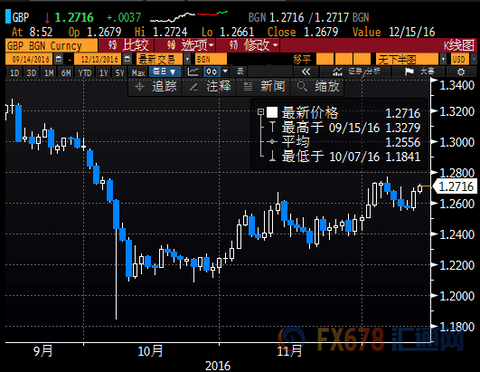
(Pound Sterling against the US dollar daily chart)
According to specific data, the UK CPI annual rate rose by 1.2% in November, the highest since October 2014, higher than the expected value of 1.1% and the previous value of 0.9%; the UK CPI monthly rate rose by 0.2% in November, the increase is in line with the expected value , higher than the previous value of 0.1%.
The National Bureau of Statistics said that the rise in CPI was driven by the prices of clothing, entertainment, and cultural industries as well as rising oil prices.
Analysts believe that the UK's inflation growth rate in November was higher than expected, which proved that the devaluation of the pound and the rise in oil prices led to the accumulation of inflationary pressures. The price outlook has changed sharply in recent days, prompting the Bank of England to change its policy stance. After the Brexit referendum, the central bank cut interest rates in August; the market expects the central bank to maintain the benchmark interest rate when it announces its last policy decision this Thursday (December 15). At the record low of 0.25% unchanged.
However, although the market generally expects that the Bank of England will not adopt new this week, nearly two-thirds of Bloomberg analysts believe that the Bank of England will raise interest rates next time, as UK inflation may rise above 2 in early 2017. % target bit.
Valeria Bednarik, principal analyst at FXstreet, said on Tuesday that the four-hour chart showed that the exchange rate was higher above the upside 20-EMA and that the technical indicators resumed their upward momentum in the positive zone. The initial resistance is at 1.2730, and the break is expected to test the previous week's high of 1.2774, followed by the July low of 1.2793. The level is confirmed to be expected to rebound further to the 1.2840 area. If the exchange rate falls below the 1.2680 level, it will reverse the upward trend and may expand the decline to the 1.2625 area.
Parka Jacket,Parka Coat,Winter Jackets,Black Parka Jacket
TUSCANY , https://www.tuscanyclothes.com